The SSD Anthology: Understanding SSDs and New Drives from OCZ
by Anand Lal Shimpi on March 18, 2009 12:00 AM EST- Posted in
- Storage
PCMark Vantage
Next up is PCMark Vantage, another system-wide performance suite. For those of you who aren’t familiar with PCMark Vantage, it ends up being the most real-world-like hard drive test I can come up with. It runs things like application launches, file searches, web browsing, contacts searching, video playback, photo editing and other completely mundane but real-world tasks. I’ve described the benchmark in great detail before but if you’d like to read up on what it does in particular, take a look at Futuremark’s whitepaper on the benchmark; it’s not perfect, but it’s good enough to be a member of a comprehensive storage benchmark suite. Any performance impacts here would most likely be reflected in the real world.
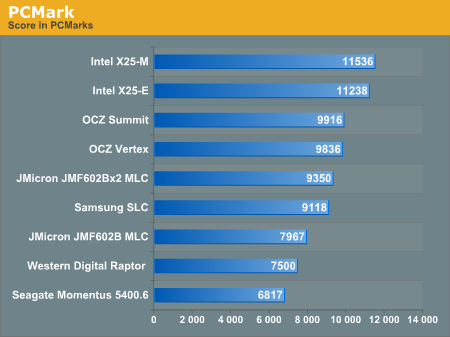
If you've paid attention to the synthetic tests from the previous pages, the results here should make sense. The Intel drives take the top two spots followed by the two OCZ drives, then the JMicron and conventional HDDs take up the rear.
While PCMark does do a great job of measuring disk performance, it doesn't seem to stress random write performance as much, allowing the JMicron drives to relax a bit.
Now let's look at the individual test suites:
The memories suite includes a test involving importing pictures into Windows Photo Gallery and editing them, a fairly benign task that easily falls into the category of being very influenced by disk performance.
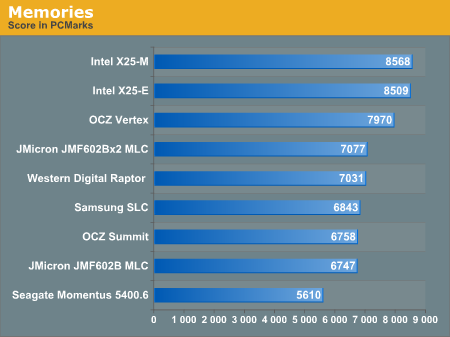
The TV and Movies tests focus on on video transcoding which is mostly CPU bound, but one of the tests involves Windows Media Center which tends to be disk bound.
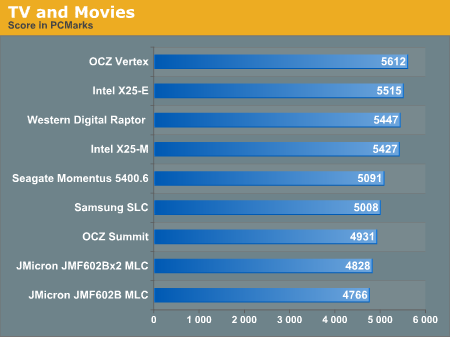
SSDs won't always dominate and in many cases they won't offer tangible improvements over a fast hard drive.
The gaming tests are very well suited to SSDs since they spend a good portion of their time focusing on reading textures and loading level data. All of the SSDs dominate here, but as you'll see later on in my gaming tests the benefits of an SSD really vary depending on the game. Take these results as a best case scenario of what can happen, not the norm.
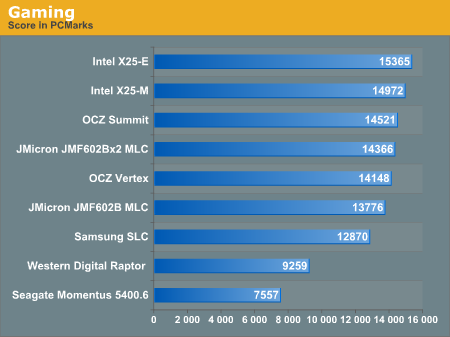
In the Music suite the main test is a multitasking scenario: the test simulates surfing the web in IE7, transcoding an audio file and adding music to Windows Media Player (the most disk intensive portion of the test).
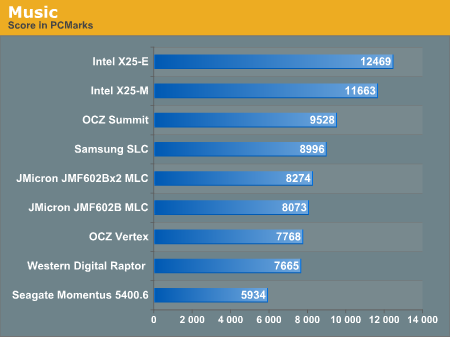
The Communications suite is made up of two tests, both involving light multitasking. The first test simulates data encryption/decryption while running message rules in Windows Mail. The second test simulates web surfing (including opening/closing tabs) in IE7, data decryption and running Windows Defender.
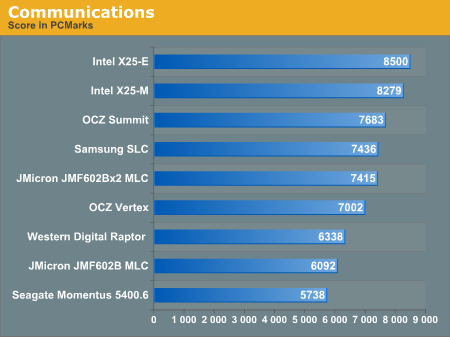
I love PCMark's Productivity test; in this test there are four tasks going on at once, searching through Windows contacts, searching through Windows Mail, browsing multiple webpages in IE7 and loading applications. This is as real world of a scenario as you get and it happens to be representative of one of the most frustrating HDD usage models - trying to do multiple things at once. There's nothing more annoying than trying to launch a simple application while you're doing other things in the background and have the load take seemingly forever.

The results here are the best characterization of my personal experience with the drives. The Intel drives are the fastest, a good 25% faster than the Summit or Vertex. Next up are the OCZ drives, with the Vertex dangerously close to the Summit. The older Samsung SLC is next in the standings, followed by the JMicron drives. There's a healthy combination of reads and writes going on here which benefits all of the SSDs, including the less desirable ones.
The final PCMark Vantage suite is HDD specific and this is where you'll see the biggest differences between the drives:
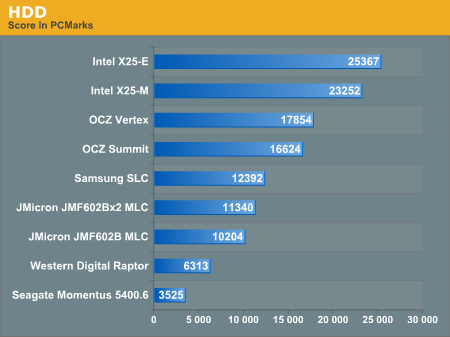
Again we're seeing the sort of breakdown we'd expect. The Intel drives come out ahead, while the Vertex is the best bang for your buck.










250 Comments
View All Comments
matrixireland - Thursday, December 24, 2009 - link
hi would like to know what you pros think of the;Golden Leopard ASAX-ZIF1.8-SSD? what would you add to it?
And how would you rate it against other ssd?
Specifications:
product description
ASAX-ZIF1.8-SSD is a high-performance design solid state drive based on the high-end micro-control IC with flash memory storage medium integrated advantaged of high speed,convenient ,aseismatic,energy-saving etc.
specification
Model
Size
Interface
Material
ASAX-ZIF1.8-SSD
1.8inch 70×54×6mm
ZIF
Aluminum-magnesium alloy appearance ,drawbench and colorful oxidation surface,elegant temperament
performance
read speed:80- 96Mbytes/second write speed:50- 60Mbytes/second
support ATA-7 V3 PIO/multi word/ultra DMA MODES
Low power TFBGA,4 channel of flash controller,masked ROM and data SRAM
SAMSUNG flash keeps the data faster on reliability and endurance
Dynamic and static wear-leveling prolong NAND FLASH and SSD for longer life
8/16 bit BCH ECC data error correction ability effectively guarantee the data read security.
Design consideration
Capacity
16G/32G/64G/128G/256G
Average access time
<0.25MS
operating temperature
0-85°
power consumption
DC Input Voltage(3.3V or 5 V ± 10%)Read and write:135mA/194Ma wait:70mA
shock
1500G
Application
the Laptop, pc, server,workstation,portable media player,digital collection apparatus and any computer equipment which need consecutive read and write speed and high reliability storage.
jay401 - Wednesday, March 18, 2009 - link
yeah, he wants "more expensive than" or "too expensive for".Spoelie - Wednesday, March 18, 2009 - link
Second page as well:missing charts before and after this paragraph:
"The chart above shows how much faster these affordable MLC SSDs were than the fastest 3.5” hard drive in sequential transfers. But now look at random write performance:"
Spoelie - Wednesday, March 18, 2009 - link
chart 1 on page 2 now shows sequential read but the paragraph is changed to mention random read ;)page 21: As far as I know, this is THE one of THE only reviews
Some very surprising benchmark results for the ocz vertex, I thought the new firmware tanked sequential read speeds (to 80-90) based on the explanation beforehand, but not according to the actual graphs.
Spoelie - Wednesday, March 18, 2009 - link
third page, first table, first column: SSD and HDD entries are switchedmikaela - Tuesday, March 16, 2010 - link
yeah great info. also great resourceSpoelie - Wednesday, March 18, 2009 - link
page 19: I’d never reviewed it'd & -ed?
HolyFire - Wednesday, March 18, 2009 - link
"I'd never reviewed it" is correct. "I'd" here means "I had", it's Past Perfect tense.FishTankX - Wednesday, March 18, 2009 - link
That should have bolded "too"FishTankX - Wednesday, March 18, 2009 - link
Also, I think the velociraptor vs X-25 figures are swapped. 6 odd ms for the intel drive and 0.11ms for the velociraptor..